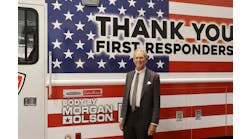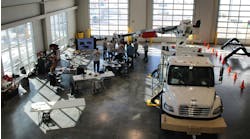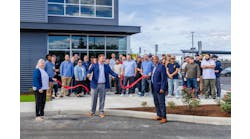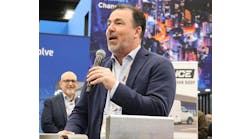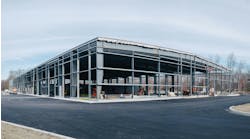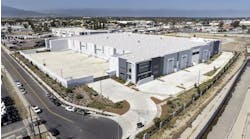Having a plan, sticking to it: At TBEI Lake Crystal, a consistent message, attainable goals keys to performance under pressure
A year into a change of ownership, TBEI’s Lake Crystal, MN, facility (home to the Crysteel Manufacturing brand), faces a challenge common to the truck body industry in 2018: Trying to keep up with a booming equipment market. But the change of ownership also brings a change of leadership to Lake Crystal, leadership that emphasizes communication—both inside the organization and outside. And, most critically, the message must be consistent, emphasizes General Manager Brett Hart.
“If you keep telling people the same thing, they get that you mean it. It’s really just setting clear goals—not something ambiguous,” Hart says. “I’m not a flavor-of-the-month guy. I believe in fundamental blocking and tackling. You don’t have to come up with the next new buzzword thing. It’s just a matter of, ‘this is where we need to go, and this is how we’re going to get there.’”
And that entails distilling the broader goal down to a workable plan on the production floor.
“Our goal here is to make sure we deliver on our promise to our customer. That means we need to maintain quality, deliver on time,” Hart says. “There are certain measures that we keep and post and talk about—it’s what we do every day. If we’re doing our job, it’s going to be reflected in those metrics.”
The new leadership style has had an immediate impact, explains HR/Safety Manager JaDee Pals. Previously, decisions were communicated from the top down—“and then they would change.”
“It broke down the credibility of the leadership. On the floor, people were saying ‘One day we were doing this, then we were doing that. What are we doing?’” she recalls. “I feel like with the new leadership there are very consistent messages from the top leadership to the floor.
“It’s about trust. Knowing that we’re here together and working to accomplish the same goals.”
The business
Federal Signal acquired TBEI from private equity firm GenNx360 Capital Partners in June last year. The $270 million acquisition was designed to allow Federal Signal to strengthen its market position as a specialty vehicle manufacturer in maintenance and infrastructure markets.
Hart came to Lake Crystal in December 2017 from Federal Signal’s Alberta-based Westech Vac Systems where he’d served as GM for two years. He has an education and background in engineering, operations and commercial leadership. Hart has held roles across multiple Federal Signal brands. He spoke to Trailer/Body Builders as the facility was preparing for the annual ISO 9001 audit.
Hart explained that deal had been a strategic one, with TBEI broadening the product portfolio into the utility and construction markets, but with similar market channels.
“Since then, we’ve focused on integration into the Federal Signal organization. A lot of people think that you come in, tear down a sign, and put up a new sign—but that doesn’t happen with Federal Signal,” he says. “Federal Signal really lets the business units operate independently. There’s an alignment from a strategy perspective, but TBEI represents multiple strong brands and we want to make sure to maintain and cultivate that.”
In addition to Crysteel, TBEI brands include Ox Bodies, Rugby, DuraClass, J-Craft and Travis Body & Trailer.
“Part of the acquisition justification was that TBEI had a pretty strong management team in place that was staying on. The key was Bob Fines.”
Fines, formerly the president and CEO, stayed on as vice president/general manager of TBEI and still runs the group from the corporate office in Hoover, AL.
“Federal Signal brought a lot to TBEI. They know the specialty vehicle space and take a long term view of our potential. Together we are investing in our processes and people,” says Fines. “We are a having a terrific year and Federal Signal is an important part of our success.”
Crysteel had been without a permanent GM for several months when Hart made the move.
“I come from the vacuum truck business. I know custom, I know quality. I know welding and painting. But the cycle was much longer; it could take a month to build a truck. Here, it’s a very lean operation,” he says. “The most impressive statistic I could give you is when that laser cuts a part from a sheet of steel, that part is welded on a finished body within 48 hours. It takes a lot to manage that.
“You have to be on the ball, every day, to make sure you’re keeping that material flow moving through the building. But it is absolutely impressive to watch.”
The market
Keeping up with a red-hot transportation equipment market is a challenge for the entire industry, and the Lake Crystal facility suffers from many of the same key issues: rising material costs, supply issues, and an acute labor shortage.
Hart’s initial marching orders: “Don’t mess up the brand.”
“Crysteel is really well known for high quality and customization. We will build those bodies that nobody else will. Our product is perceived as premium quality,” Hart says. “But from an execution standpoint, we’ve had this big backlog for a year: How do we reduce that? How do we shrink those lead times? How do we add capacity so we can do this?
“It’s a high-class problem to have: We’ve got orders outpacing our ability to ship—but still it’s a problem. Our customers aren’t used to stretched lead times. What do we have to do to reduce that without compromising our product?”
One solution is automation.
“Every bit of productivity improvement we can get by using automation eases the strain on the headcount that we need,” Hart says. “The challenge with automation in a business like ours is that you may think dump bodies are all the same, but they’re not. They have so much variation that it makes automation integration extremely difficult. But we have active projects right now with the goal of implementing more automation into our processes.”
So that means the manufacturer still needs human beings.
“Our problem here in southern Minnesota is the unemployment rate is 3%, and we can’t find the skilled labor we need,” he says. “Three years ago, the talk was manufacturing jobs are gone and never coming back, yet here we are: We literally today cannot find enough welders and finish painters to execute.”
Hart credits Pals’ efforts as a recruiter.
“She’s doing everything except standing out on the highway waving a sign,” he says. “She’s done an amazing job, but it’s a very competitive market.”
Personnel strategies
And in talking with Pals, a certified Professional in Human Resources, it becomes clear that she is indeed doing a little bit of everything.
The Lake Crystal facility currently employs about 200 people, with the majority being direct employees of the company along with contract workers. Employees come from a 40- to 50-mile radius, encompassing a largely rural and agricultural area.
But in a highly competitive area for skilled positions, she explains, welders and fabricators are constantly tempted by the possibility of greener pastures. And pay is the leading lure. At Lake Crystal, the company offers a “pay-for-progression” model that provides team members opportunities for a series of pay increases in their first couple of years with the company. The increases can go as high a $1 per hour. Additionally, the starting pay has recently gone up $2/hour, with the top range rising $4/hour.
Team members are assigned positions based on their skill levels. Welders, for instance, perform a “weld demo,” in which they have the opportunity to “showcase their skills,” Pals explained.
“If they don’t score very high, we can’t start them out at the pay they may feel they’re worth,” Pals explains. “But with the pay-for-progression model, if they’re doing well they’ll get to that pay or higher. Onboarding team members really like to hear they’ll have the opportunity for eight pay increases in their first two years.”
TBEI also offers quarterly incentive bonuses for meeting site-wide goals, typically based on improved performance compared to the previous year.
“We’re climbing a ladder, not aiming too high so folks don’t feel like it’s unattainable and they’ll reach for it,” she says. “It doesn’t happen every time, but we’ve tried our best to work together to get through the hurdles so that the bonuses can be paid out.”
Attendance is a key eligibility criterion, and a bonus opportunity on its own. The company allows for 10 unplanned “occurrences” in a rolling 12-month period.
“Some companies in the area, because they’re job-based, may not have strict deadlines and therefore a more flexible attendance policy,” Pals notes. “But here we have a value-stream flow, and if we’ve got people gone it’s going to significantly impact that line. We have to be at work.”
The Lake Crystal facility’s normal workweek is four 10-hour days, with a fifth day of required overtime when necessary.
“Some departments know they’ll be working Fridays for a while; some might not know until Wednesday,” Pals said. “It’s a balance. If you have a lot of overtime, some people love it and some people don’t.”
A focus group has provided “really good feedback” on the unplanned absence issue; specifically, that employees felt they couldn’t take time off during busy periods.
Supervisors, on the other hand, felt they were cooperative in handling the time off—except for those that come at the last minute.
As a result of the feedback, Pals has taken steps to formalize the time-off requests.
Recruiting
The candidate pool is changing, and younger people seem less interested in manufacturing work, Pals suggests. Several regional organizations have worked to get the message out that such jobs are available, and for good pay and benefits—but college has become the default post-high school choice for most graduates.
That said, the company has partnered with area high school welding programs, and it offers paid summer internships. The students go through the same interview and skills evaluation as any other candidate. One recent intern, because of his skill level, earned regular employee pay—and he planned to come back for a second summer.
“Last year, based on his pay and all the hours he got, he bought a new pickup,” Pals says. “So he’s pretty excited about that.”
Another hire, a recent high school grad, volunteered to return to his school to show younger students examples of his work, and to talk about the job. The facility also welcomes student tours.
Additionally, TBEI works with the “very strong” welding program at nearby South Central College, a community and technical college that is part of the Minnesota State system. As part of the weld advisory group, company representatives provide feedback on the skills TBEI is looking for, and how the business is evolving. And on recruiting visits, Pals will bring along a trainer from the company to work “side-by-side” with the students and their instructors—and to build relationships.
“I think it will take some time for the community to really recognize that these are all great positions, and maybe you can start there and decide if that’s what you want to do,” Pals said. “We’re trying to get those opportunities in front of the students, so they know what they can earn in these great trade positions.”
Other recruiting and retention programs include a $1,000 referral bonus, and a $2,000 “double-sided, double-bonus” promotion for key positions such as welders and finish painters, which paid both the referrer and the recruit who signed on.
“We had incremental payouts, that added up to $2,000 over 12 months—but they had to have good attendance. So it encouraged current team members to refer people who would have good attendance, and then to help the recruit show up for work, too,” Pals says. “We got a lot of traction, and filled almost every position. It was absolutely worth the investment.
“I’d rather pay that out to employees, than continue to pay for recruitment costs. It’s a much better use of our money to pay for retention.”
Training
On the training side, TBEI partnered with Minnesota State University, Mankato on a state grant designed to support Minnesota businesses. The grant supports business leadership, lean manufacturing, and welding skills training.
The money went to on-site training programs, and included bringing in instructors in new and advanced techniques “to improve the talent level within the company.”
“We have a lot of great welders, but not all of them knew how to weld stainless steel or aluminum,” Pals says. “Our product mix was changing, and this helped us to increase the skills that we needed to tackle the demands from our customers and do it with the great quality that we’re known for.”
Unskilled team members at Lake Crystal also have the opportunity to be trained and move into other positions. If an employee wants to become a welder, they can participate through a community education training scholarship program which is led by TBEI trainers.
“Right now there tends to be a waiting list, because there’s high demand in the area for folks who want to learn to weld, which is a good sign. We actually added more classes to make sure we can get folks through, and not have to wait three months for the next class.”
A “significant number” of TBEI team members have taken advantage of the opportunity.
“They do a wonderful job, and now they’re making big money for a skilled position,” Pals says. “They have nothing to lose and everything to gain when they come in here and want to tackle that program.”
Pricing
Of course, skilled labor isn’t the only challenge. Cost inflation is surging across the industry.
“On the material side, I feel terrible when I have to send a price increase. You try to keep it as modest as possible for your distributor, but the cost pressure is real and wide ranging,” says Lake Crystal GM Hart. “It’s not just steel. From late winter on, the materials cost increases have begun to pile up. It’s become a significant drain on our internal resources, trying to keep up.”
And pricing is another area where the extended backlog is a problem. But TBEI has the benefit of a supply-chain team at the group level, Hart notes. The team handles purchases of material common to the group such as steel, hydraulics, axles and PTOs.
“As we’re trying to ramp up, everyone else is trying to ramp up,” he says. “We’re trying to do as much forecasting and communication as possible, but as we’re stretched our supply base is stretched—and we’re not their only customer.
“From a supply chain standpoint, when you choose a vendor you need to know where you land on their pecking order. You don’t want to be the small fish in a big pond. But, at the same time, from a stability standpoint you don’t want to represent 80% of that supplier’s business—because if you have to throttle back you may put them at risk.”
On the flipside of supplier/customer issues, Lake Crystal in turn strives to keep its customers happy—or at least well informed of what to expect.
While Hart hesitated to admit having to “pick and choose” among customers, he did recognize that there are “strategic” accounts and commitments. And again, communication is the key to keeping them happy.
“Things happen,” he says. “Maybe we had a little better week of production and have some extra capacity. Our inside sales team really does a good job of making sure they take care of the orders that truly need to be expedited.”
Looking ahead
Hart says he’s too busy keeping up with today’s demand to focus on the inevitable downturn in the business cycle.
“We’re still making hay while the sun’s shining, for sure. We won’t throttle back until we get our lead time in line with expectations,” he says. “We’re getting a little bit of reprieve because the chassis suppliers are stretched out quite a bit. That’s giving us some cover.”
But the tide will turn, he concedes.
“We do know this for a fact: We are in the late stages of the current business cycle. That is reality,” Hart says. “But right now the market is still strong. We have fantastic distributors and solid direct, end-user customers. We have a great brand. Our focus right now is to just continue to deliver on our promise to our customers.”
Hart, in the course of his career, has learned not to shy away from an opportunity because he wasn’t yet an expert in the market or the product. Management is much more about people, he reiterates.
“At the end of the day, businesses are just made up of people. Do you have the right culture? Do you have the right talent to execute on a plan?” he says. “The reassuring factor here is we have a lot of employees with tenure, who take a tremendous amount of pride in their work. They really view it as craftsmanship, and that they’re putting their name on something they can be proud of.”
Indeed, as Pals adds, just the weekend before team members had participated in a local parade, bringing along a particularly impressive new truck before it was delivered to a customer.
“We really like to show off our trucks,” she says. “It’s neat to see the pride our employees take in their work, and we need to be able to show the community what we do and the different positions that we offer.”
